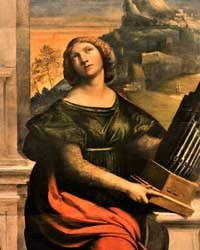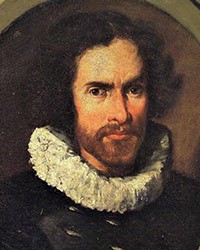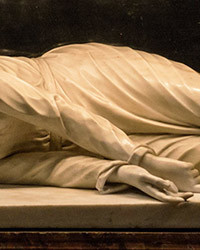Carlo Saraceni’s St. Cecilia with an Angel - two musicians

Carlo Saraceni, Saint Cecilia with an Angel, fragment, Galleria Nazionale d'Arte Antica, Palazzo Barberini

Saint Cecilia with an Angel, Carlo Saraceni, Galleria Nazionale d'Arte Antica, Palazzo Barberini

Saint Cecilia with an Angel, fragment, Carlo Saraceni, Galleria Nazionale d'Arte Antica, Palazzo Barberini

Saint Cecilia with an Angel, fragment, Carlo Saraceni, Galleria Nazionale d'Arte Antica, Palazzo Barberini

Carlo Saraceni, Saint Cecilia with an Angel, fragment, Galleria Nazionale d'Arte Antica, Palazzo Barberini

Carlo Saraceni, Saint Cecilia with an Angel, fragment, Galleria Nazionale d'Arte Antica, Palazzo Barberini

Carlo Saraceni, The Martyrdom of St. Cecylia, Los Angeles, Country Museum of Art, pic. Wikipedia

Hendrick Ter Brugghen, Concert, Galleria Nazionale d'Arte Antica, Palazzo Barberini
How does one paint an angel? That is the question that filled the minds of painters and art theoreticians since the time of the Renaissance. A clergyman and a writer Giovanni Maria Tarsia from Florence in his treatise entitled Trattato della Natura degli Angeli (On the Nature of Angels, 1576) asked how is he to write about them if he had never seen them. Despite similar doubts, angels had already appeared in art in early-Christian times, although at that time they still did not have wings. These grew as time passed, attaining enormous dimensions, which can be testified to by those that the Guardian Angel of St. Cecilia has, on the canvas painted by Saraceni.
How does one paint an angel? That is the question that filled the minds of painters and art theoreticians since the time of the Renaissance. A clergyman and a writer Giovanni Maria Tarsia from Florence in his treatise entitled Trattato della Natura degli Angeli (On the Nature of Angels, 1576) asked how is he to write about them if he had never seen them. Despite similar doubts, angels had already appeared in art in early-Christian times, although at that time they still did not have wings. These grew as time passed, attaining enormous dimensions, which can be testified to by those that the Guardian Angel of St. Cecilia has, on the canvas painted by Saraceni.
The painting enslaves with its wealth of cold and warm tones. The sharp “Caravaggio-like” light coming from the left strongly illuminates the inner part of the angel’s wings, his arm, face, and Cecilia’s cleavage and settles on the shiny fabric of her skirt. This exceptionally beautiful composition appeared quite suddenly as a phoenix from the ashes, and it immediately aroused questions: who is the author, who commissioned the painting, where had it been until now, and why had not anybody known about its existence?
Since that time some of these questions have been answered. We know that the painting depicts Saint Cecilia and that it was painted around 1610 by the Venice-born, but active in Rome (since the end of the XVI century) Carlo Saraceni – one of the first admirers of Caravaggio’s painting. In comparison to the works of this master, the canvases created by Saraceni were less veristic and did not emanate the excessive ugliness of dirty feet, vein-filled legs, or earthly, wrinkled faces. They were lyrical and elegant – as would have been fit for a Venetian, but most of all a lot less controversial in the iconographic dimension. Today historians have no doubts that the representation of Cecilia with an angel is the work of Saraceni. Initially, however, it was attributed to various artists, including the Frenchman who worked in his workshop Guy François. Some French historians even go as far as to claim that the painting is the work of both of these painters.

When Caravaggio fled Rome in 1606 pursued by an arrest warrant, his companions including Saraceni had naturally acquired a large number of clients in the city, who had desired paintings, if not painted by the master himself, at least by those similar to him, whom presently we refer to as Caravaggionists. And there were many of them indeed. Due to the Jubilee Year (1600) painters from various parts of Italy came to Rome, but also others from France, the Netherlands, and Spain, while a true artistic ferment prevailed within the city. It is estimated that there were over two thousand artists in Rome, and several of them even came through Saraceni's workshop. In this way, the painter was able to accommodate all orders, which came from private collectors and the Church. One of these had to be the buyer of our painting, who wanted a religious scene but one that would not be quite devotional but rather decorative and also one that could spark a discussion on the subject of art and music. Unfortunately even today we do not know the name of the painting's owner, showing the future martyr – a young Cecilia, who had already abandoned the pagan beliefs of her ancestors and became a Christian. How do we know? Jacobus de Voragine in his Golden Legend, which became an inspiration for many painting works, claimed that Cecilia had not only seen her Guardian Angel but had also talked with him. As she told her husband Valerian, the only ones who could see him are those who had abandoned pagan deities, were baptized and led a life of modesty and purity – similar to angels. This medieval story was repeated by Antonio Bosio in his Story of the Passion of St Cecilia written in the year 1600. It was published a few months after, the untouched by time corpse of the saint was discovered in the Church of Santa Cecilia on the Trastevere. From that moment the martyr’s popularity had become equal to those enjoyed today by celebrities and gave the assumption to create a limitless number of her images.

In Saraceni's painting, Cecilia's Guardian Angel had to have been seen by her in the past and was even befriended by her, since they were making music together. It is as if he had paid a brief visit to the musical salon of a Roman aristocrat in order to practice a few passages with her. The angel extends his finger towards the heart of the woman who is tuning her lute as if trying to direct her attention toward something. Perhaps he is lecturing her, as their eyes meet. We see that the angel is speaking with Cecilia, but what language is he using. Saint Paul claimed that the angelic language is not understood by mere mortals – therefore had Cecilia already learned his tongue, or is it, as Saraceni seems to suggest music, that becomes a universal method of communication between humans and angels?
Here, it might be worth recalling the words written in the XVI century by a humanist and a clergyman Sabba da Castiglione, who claimed that musical instruments found in the houses of many people of those times, bring joy not only to the ear but also to the eyes and stimulate our souls, since (as Plato claimed) music is a reflection of the harmony created by heavenly circles. It is rather obvious that the subject of music in painting had become an especially popular motif in the XVII century, while Cecilia is in many paintings simply a pretext to show beautiful instruments and young women making music. In reality, more and more often women were educated in the field of music under the watchful gaze of excellent teachers, while playing music together had become fashionable among the educated elites and aristocrats. Moreover, it was a testimony to their refinement and high social standing. Women were also successful in playing an instrument and singing, although officially a publically playing or singing woman was looked down upon. That is why, the then female virtuosos of the harp or lute, who wanted to devote their lives to music, often either chose the convent, in order to silence the critics, or they were protected by important Italian courts such as the one in Florence. In the city on the Tiber, music performed by women was only well-seen when it was kept to the confines of one's home and was heard solely by its inhabitants. Let us not forget, that these were the times of rigorous and Counterreformationist moralism, which was particularly applicable in Rome. On the other hand, it must also be remembered that an indispensable element of the education received by courtesans (cortigniana nobile) was the ability to play a musical instrument. The topic of women making music did of course appear in painting (also in the Eternal City), however, most often it could be seen in scenes located on the outskirts even in brothels (Hendrick Ter Brugghen, The Concert) which unanimously marks the subject of music and women as sinful.

Cecilia was considered to be the patron of church music, however, the instruments found around her – harp, violin, and two flutes (bombarda, flauto dolce) were used to perform the fashionable at that time chamber concerts. On the other hand, no organs are present, which should definitely be identified with the patron of religious music. The angel accompanies the saint on an instrument known as the violene (a distant ancestor of the string bass), which elicits a dark, low tone, that fit in perfectly with the sounds of the lute, which is being tuned by Cecilia. And it is this kind of genre scene, far removed from religious emphasis, which was painted by Saraceni. This kind of secularism of the painting is highlighted by the instruments creating a sort of still nature, enriching the composition and bringing joy to the eyes, as Castiglione had claimed.
The painting was bought for the museum collection at the end of the XIX century. Since that time it had been part of the Monte di Pietà collection – an organization that is part a charity and part a bank (a pawnshop of sorts), which gave out low-interest credits and loaned money as a pledge. The painting was probably turned over during a time of financial troubles experienced by the owner and it had never returned to his possession.
Saint Cecilia with an Angel, Carlo Saraceni, 1610, oil on canvas 172 ´ 139 cm, Galleria Nazionale d’Arte Antica, Palazzo Barberini
If you liked this article, you can help us continue to work by supporting the roma-nonpertutti portal concrete — by sharing newsletters and donating even small amounts. They will help us in our further work.
You can make one-time deposits to your account:
Barbara Kokoska
BIGBPLPW 62 1160 2202 0000 0002 3744 2108
or support on a regular basis with Patonite.pl (lower left corner)
Know that we appreciate it very much and thank You !



























